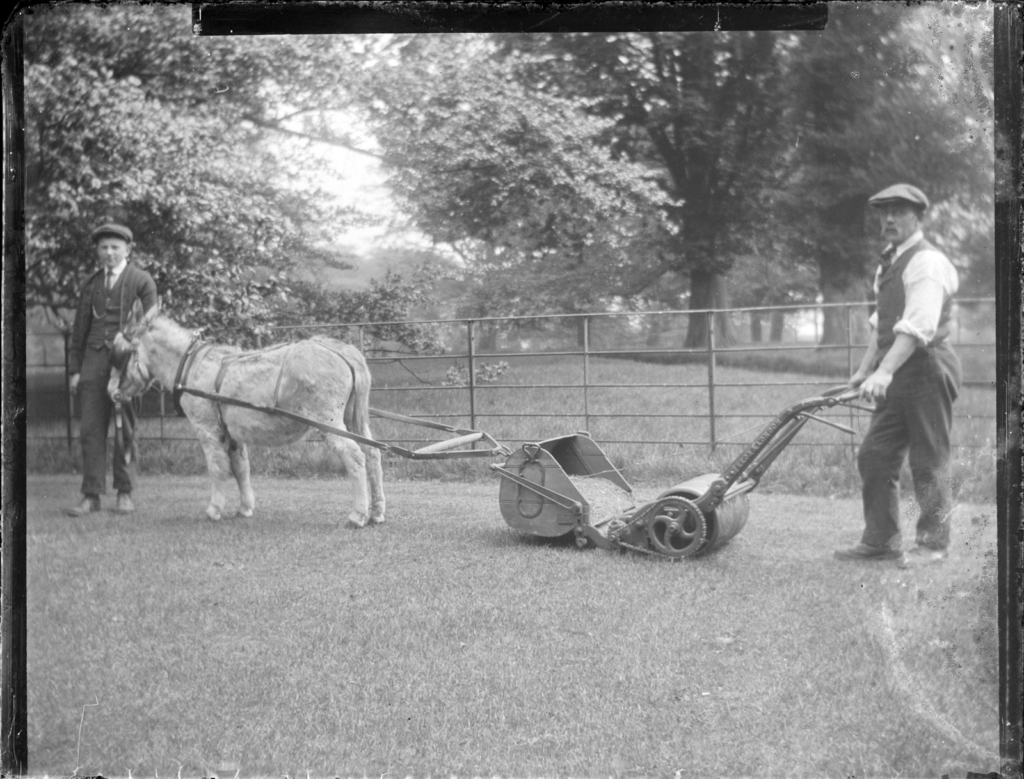Now it is July, and you may have put in your diary the dates for the next RHS Flower Show at Tatton Park, which is between 19 to 23 July. It is high summer and everything in your garden will be in full growth, so I thought it appropriate to take a look at . . . . . . . . . lawnmowers!
During the 18th century landscape designers, including William Kent, Charles Bridgeman and Lancelot ‘Capability’ Brown, began what became known as the English Landscape Garden movement. The cropped grass of lawns next to the house was established as an indispensable element of garden design. To achieve this men with scythes would regularly trim the grass trying to achieve as smooth a surface as possible. This was an extremely labour intensive and skilled task so the earliest lawns were very much the preserve of the elite.
In the USA grass cutters such as the Climax Mower were advertised which was suitable for larger areas. It was described as “The most complete and perfect mower in the world.”

Many inventors were trying to develop an efficient machine to cut smaller areas of grass and it was in 1830 that Edwin Beard Budding (25 August 1796 – 25 September 1846 when he died of a stroke at the age of 50) filed a patent for the modern lawn mower. He worked as an engineer in a textile mill in Stroud, Gloucester, and was inspired by a machine used to trim the nap off cloth used for uniforms. He thought the same idea could be used to cut grass.

Budding’s mower was designed primarily to cut the lawn on sports grounds and expansive gardens as a superior alternative to the scythe. His patent of 31 August 1830 described “a new combination and application of machinery for the purpose of cropping or shearing the vegetable surfaces of lawns, grass-plats and pleasure grounds. Country gentlemen may find in using my machine themselves an amusing, useful and healthy exercise.”
The early machine was cast iron and was 19 inches wide. The lawn mower was pushed from behind, with the rear roller driving the gears and the knives on the cutting cylinder. Another roller, in between the cutting cylinder and the land roller, could be adjusted to alter the height of the cut.
Grass clippings were propelled forward into a box, where they were collected and manually emptied.

Examples of the early Budding type mowers can be seen in the London Science Museum, the Milton Keynes Museum and the Stroud Museum (where you can also find the adjustable spanner, and a pepperpot revolver that he invented).
In an agreement dated 18 May 1830 Budding went into partnership with local engineer John Ferrabee and they manufactured mowers at Ferrabee’s Phoenix Iron Works at Thrupp, Stroud where there is now a blue commemorative plaque. They modified the design to enable a second person or animal to pull the heavy mower. They also allowed other companies to build copies of their mowers under license. When the early patents expired in the 1850s, other companies introduced their own lines of machines.
One of the first of Budding and Ferrabee machines was used in Regent’s Park Zoological Gardens in London Zoo in 1831 while another was purchased by the Oxford colleges. It took another 10 years and further innovations to create a machine that could be worked by donkey or horse power and 60 years before a steam-powered lawnmower was built.

In 1888, the side wheel mower was introduced in England. The cast iron wheels on either side drove the cutting cylinder directly via ratchets inside the castings. This design was very light to operate, and inexpensive to manufacture. The side wheel mower became popular all over the world, including the United States.

Looking at mowers today, as an illustration of what can be achieved, in 2017 at the King Power Leicester Football Ground groundsman John Ledwidge and his team mowed the Foxes emblem into the grass.

So, happy mowing!

